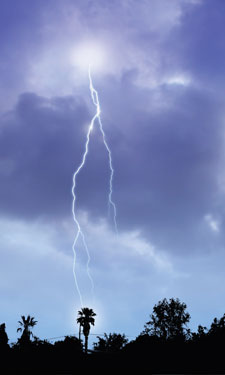 At any one time across the world, there are around 40-50 lightning events every second, or around four million strikes per day, according to satellites monitoring the atmosphere. It’s a natural phenomenon that commands a healthy dose of respect for the energy it unleashes and that can instantly elicit feelings of fear and create a dangerous situation. But, for all the “negativity” surrounding it, lightning plays a crucial role in fertilizing soil (by helping to dissolve nitrogen in the atmosphere in water so that plants can absorb it through their roots) and in protecting the earth, with the ozone it produces, from the sun’s ultraviolet rays. There are several myths about lightning, the most common being that it never strikes the same place twice. Towers, tall buildings like New York’s Empire State Building and Chicago’s Sears Tower, and even some people — Roy Cleveland Sullivan (February 7, 1912 – September 28, 1983) a United States park ranger in Virginia’s Shenandoah National Park between 1942 and 1977, was hit by lightning on seven different occasions and survived all of them — can attest to this falsehood. As we approach the beginning of spring and, soon, pool season, a refresher on lightning safety may be a wise course of action. Following are some interesting facts about lightning:
At any one time across the world, there are around 40-50 lightning events every second, or around four million strikes per day, according to satellites monitoring the atmosphere. It’s a natural phenomenon that commands a healthy dose of respect for the energy it unleashes and that can instantly elicit feelings of fear and create a dangerous situation. But, for all the “negativity” surrounding it, lightning plays a crucial role in fertilizing soil (by helping to dissolve nitrogen in the atmosphere in water so that plants can absorb it through their roots) and in protecting the earth, with the ozone it produces, from the sun’s ultraviolet rays. There are several myths about lightning, the most common being that it never strikes the same place twice. Towers, tall buildings like New York’s Empire State Building and Chicago’s Sears Tower, and even some people — Roy Cleveland Sullivan (February 7, 1912 – September 28, 1983) a United States park ranger in Virginia’s Shenandoah National Park between 1942 and 1977, was hit by lightning on seven different occasions and survived all of them — can attest to this falsehood. As we approach the beginning of spring and, soon, pool season, a refresher on lightning safety may be a wise course of action. Following are some interesting facts about lightning:
- 800: Number of thunderstorms discharging lightning at any one time worldwide.
- 20 million-25 million: Number of ground strikes per year in the United States, roughly.
- $4 billion-$5 billion: Annual cost of damage from lightning in the United States.
- 1: Number of strikes needed to operate a 100-Watt bulb for one month.
- 50,000-60,000o F: Average temperature of a negatively charged lightning strike (five times hotter than the surface of the sun).
- 90,000 miles per second: Speed of a lightning strike (100 million feet per second).
- 1-2 inches: Average thickness of a bolt.
- 7: Types of lightning strikes recognized by the National Weather Service: intra-cloud, cloud to cloud, cloud to ground, cloud to air, bolt from the blue, anvil lightning and heat lightning.
- 10 miles+: Distance away from any rainfall that lightning can strike.
- 24.7: Number of strikes per square mile in the state most prone to lightning strikes: Florida.
- 0.3: Number of strikes per square mile in the state least prone to lightning strikes: Washington.
Sources: The National Weather Service’s Severe Weather Safety Guide: Lightning, the National Lightning Safety Institute, the Weather Channel, All About Lightning by Martin A. Uman and Lightning: Nature and Culture by Derek Elsom

